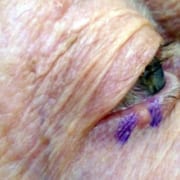What do Eyes Have to do With It?

You might not think of an eye exam as part of your annual skin check visit to the dermatologist, but there are several serious conditions, including cancers of the eyelids, that can be easily missed without a thorough examination. Your annual skin check should include a visualization of the upper and lower eyelids for tumors, assessment of hair distribution along the lash line to check for alopecia, as well as evaluation of eye symptoms, such as eye irritation or a gritty sensation, which can be associated with skin conditions like rosacea.
If a suspicious skin growth is found on or near the eyelid region, a biopsy should be performed to determine the type of lesion present. The most common malignant growths of the eye area are basal cell carcinoma and squamous cell carcinoma. Other less common types of eyelid cancers are sebaceous carcinoma, Merkel cell carcinoma, and intraocular melanoma. Risk factors for eyelid skin cancers include fair skin (blue eyes and red or blonde hair), immunosuppression, and history of previous radiation to the face.
Types of eyelid skin cancers
Basal Cell Carcinoma (BCC): The eyelid skin is extremely vulnerable to damage from the sun’s ultraviolet rays, making non-melanoma skin cancers, like BCC, quite common. While BCCs rarely spread to the bloodstream, they can grow large and cause disfigurement and sometimes even loss of the eye; this necessitates prompt removal with Mohs surgery, which is sometimes performed in consultation with an oculoplastic surgeon. To prevent BCCs of the eyelids, I recommend that you wear UV blocking sunglasses and don a hat — the wider the brim the better. And of course, always wear sunscreen. Stick Sunscreens for sensitive skin are generally well-tolerated around the eyes.
Squamous Cell Carcinoma (SCC): SCCs make up a smaller portion of eyelid cancers, but have a slightly higher risk of metastasis than BCCs. Prevention and treatment of eyelid SCC is similar to BCC.
Melanoma: Intraocular melanoma is the most common type of cancer that can develop within the eye in adults, yet it is still very rare. It can be found in the back of the eye in the pigmented layer of the eyeball, known as the uvea. This area is not visible to eye doctors during a regular eye exam, therefore it is crucial for individuals with a personal or strong family history of melanoma to undergo yearly dilated eye exams with an ophthalmologist. It is unclear how intraocular melanoma develops, although there are individuals who are genetically predisposed. Anyone with light hair and eye color is at a higher risk of developing eye melanoma, as are welders — either through increased occupational ultraviolet radiation exposure or other environmental causes. Melanoma is a serious diagnosis due to its ability to spread to the bloodstream and other organs. Treatment of intraocular melanoma may include surgery, radiation, and chemotherapy.
Bottom line: Check your eyelids for new growths and protect your eyes from UV exposure. Your eyes are not impervious to skin cancer!
References
Bain, J. (September 25, 2018). Focus on Eyelid Skin Cancers: Early Detection and Treatment. The Skin Cancer Foundation. Available online at: https://www.skincancer.org/blog/eyelid-skin-cancers/
Katella, K. (July 24, 2018). For Eye Cancer, Exams are Crucial. Yale Medicine. Available online at: https://www.yalemedicine.org/stories/eye-cancer-prevention/
Mayo Clinic Staff (September 18, 2018). Eye Melanoma. Available online at: https://www.mayoclinic.org/diseases-conditions/eye-melanoma/diagnosis-treatment/drc-20372376.



